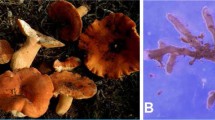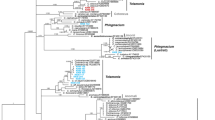Abstract
Ectomycorrhizal fungi, especially basidiomycetes, have repeatedly evolved from saprotrophic ancestors. Using rDNA internal transcribed spacer and large subunit sequences, we demonstrate that four species of Coltricia and Coltriciella form ectomycorrhiza with the native Vateriopsis seychellarum (Dipterocarpaceae) and Intsia bijuga (Caesalpiniaceae) as well as the introduced Eucalyptus robusta (Myrtaceae) in Seychelles. Coltricia and Coltriciella species share a thin, orange-brown to dark brown mantle and extremely thick, clampless hyphae. Phylogenetic analyses placed Coltriciella monophyletic within Coltricia. This study provides further evidence that fruiting habit on dead wood does not indicate saprotrophic lifestyle.


Similar content being viewed by others
References
Agerer R (1991) Characterization of ectomycorrhiza. In: Norris JR, Read DJ, Varma AK (eds) Techniques for the Study of Mycorrhiza. Academic, London, pp 25–73
Agerer R (2006) Fungal relationships and structural identity of their ectomycorrhizae. Mycol Progress 5:67–107
Aime MC, Henkel TW, Ryvarden L (2003) Studies in neotropical polypores 15: new and interesting species from Guyana. Mycologia 95:614–619
Binder M, Hibbett DS (2002) Higher level phylogenetic relationships of Homobasidiomycetes (mushroom-forming fungi) inferred from four rDNA regions. Mol Phyl Evol 22:76–90
Binder M, Hibbett DS, Larsson K-H, Larsson E, Langer E, Langer G (2005) The phylogenetic distribution of resupinate forms across the major clades of mushroom-forming fungi (Homobasidiomycetes). Syst Biodiv 3:113–157
Brand F (1991) Genea hispidula. In: Agerer R (ed) Colour Atlas of Ectomycorrhizae, plate 57. Einhorn, Schwäbisch Gmünd
Corner EJH (1991) Ad Polyporaceas VII. The xanthochroic polypores. Nova Hedwigia 101:1–175
Cunningham GH (1948) New Zealand Polyporaceae. 6. The genus Coltricia. Plant Dis Div Bull 77:1–13
Danielson RM (1984) Ectomycorrhizal associations in jack pine stands in northeastern Alberta. Can J Bot 62:932–939
Egger KN, Hibbett DS (2004) The evolutionary implications of exploitation in mycorrhizas. Can J Bot 82:1110–1121
Grand LF, Vernia CS (2005) Biogeography and hosts of poroid decay fungi in North Carolina: species of Coltricia, Coltriciella and Inonotus. Mycotaxon 91:35–38
Harvey AE, Jurgensen MF, Larsen MJ (1978) Seasonal distribution of ectomycorrhizae in a mature Douglas fir/larch forest soil in Western Montana. For Sci 24:203–208
Harvey AE, Jurgensen MF, Larsen MJ (1981) Organic reserves: importance to ectomycorrhizae in forest soils of westwern Montana. For Sci 27:442–445
Henkel TW, Aime MC, Miller SL (2000) Systematics of pleurotoid Russulaceae from Guyana and Japan, with notes on their ectomycorrhizal status. Mycologia 92:1119–1132
Henkel TW, Aime MC, Mehl HK, Miller SL (2006). Cantharellus pleurotoides, a new and unusual basidiomycete from Guyana. Mycol Res 110:1409–1412
Hibbett DS, Donoghue MJ (2001) Analysis of character correlations among wood decay mechanisms, mating systems, and substrate ranges in homobasidiomycetes. Syst Biol 50:215–242
Hibbett DS, Gilbert L-B, Donoghue MJ (2000) Evolutionary instability of ectomycorrhizal symbioses in basidiomycetes. Nature 407:506–508
Katoh K, Kuma K, Toh H, Miyata T (2005) MAFFT version 5: improvement in accuracy of multiple sequence alignment. Nucleic Acids Res 33:511–518
Larsson K-H, Larsson E, Kõljalg U (2004) High phylogenetic diversity among corticioid homobasidiomycetes. Mycol Res 108:983–1002
Larsson K-H, Parmasto E, Fischer M, Langer E, Nakasone KK, Redhead SA (2006) Hymenochaetales: a molecular phylogeny of the hymenochaetoid clade. Mycologia 98:926–936
LoBuglio KF, Berbee ML, Taylor JW (1996) Phylogenetic origins of the asexual mycorrhizal symbiont Cenococcum geophilum Fr. and other mycorrhizal fungi among the ascomycetes. Mol Phyl Evol 6:287–294
Nylander JAA (2004) MrModeltest 2.2. Program distributed by the author. Evolutionary Biology Centre, Uppsala University, Sweden
Pachlewski R, Chrusciak E (1980) Aktywnosc enzymatyczna mikoryzowych II (in Polish). Acta Mycol 16:97–103
Ronquist F, Huelsenbeck JP (2003) MrBayes 3: Bayesian phylogenetic inference under mixed models. Bioinformatics 19:1572–1574
Ryvarden L, Johansen I (1980) A preliminary polypore flora of East Africa. Fungiflora, Oslo
Singer R (1984) Tropical Russulaceae II. Lactarius section Panuoidei. Nova Hedwig 40:435–447
Swofford DL (2002) PAUP*. Phylogenetic analysis using parsimony (*and other methods). Version 4. Sinauer, Sunderland
Taylor AFS, Alexander IJ (2005) The ectomycorrhizal symbiosis: life in the real world. Mycologist 19:102–112
Tedersoo L (2007) Ectomycorrhizal fungi: diversity and community structure in Estonia, Seychelles and Australia. PhD Thesis, University of Tartu, Tartu, Estonia
Tedersoo L, Kõljalg U, Hallenberg N, Larsson K-H (2003) Fine scale distribution of ectomycorrhizal fungi and roots across substrate layers including coarse woody debris in a mixed forest. New Phytol 159:153–165
Tedersoo L, Hansen K, Perry BA, Kjøller R (2006) Molecular and morphological diversity of pezizalean ectomycorrhiza. New Phytol 170:581–596
Tedersoo L, Pellet P, Kõljalg U, Selosse M-A (2007a) Parallel evolutionary paths to mycoheterotrophy in understorey Ericaceae and Orchidaceae: ecological evidence for mixotrophy in Pyroleae. Oecologia. 151:206–207
Tedersoo L, Suvi T, Beaver K, Kõljalg U (2007b) Ectomycorrhizal fungi of the Seychelles: diversity patterns and host shifts from the native Vateriopsis seychellarum (Dipterocarpaceae) and Instia hijuga (Caesalpiniaceae) to the introduced Eucalyptus robusta (Myrtaceae), but not Pinus caribea (Pinaceae). New Phytol (in press). DOI 10.1111/j.1469-8137.2007.02104.x
Thoen D, Ba AM (1989) Ectomycorrhizas and putative ectomycorrhizal fungi of Afzelia africana and Uapaca guineensis in southern Senegal. New Phytol 113:549–559
Wagner T, Fischer M (2002a) Classification and phylogenetic relationships of Hymenochaete and allied genera of the Hymenochaetales, inferred from rDNA sequence data and nuclear behaviour of vegetative mycelium. Mycol Progress 1:93–104
Wagner T, Fischer M (2002b) Proceedings towards a natural classification of the worldwide taxa Phellinus s.l. and Inonotus s.l., and phylogenetic relationships of allied genera. Mycologia 94:998–1016
Acknowledgements
We thank D. Dogley, J. Mougal, Y. Juliette and staff of the Forestry Section (Ministry of Environment and National Resources, Seychelles) for help, information and support in Seychelles; U. Kõljalg for sequencing C. tasmanica; H. Tamm and B. Kullman for assistance in sectioning; E. Parmasto for identifying the specimens from Seychelles and China; two referees and E. Parmasto for constructive comments on earlier versions of the manuscript. This study was funded by the Estonian Science Foundation grant no. 6606.
Author information
Authors and Affiliations
Corresponding author
Rights and permissions
About this article
Cite this article
Tedersoo, L., Suvi, T., Beaver, K. et al. Ectomycorrhizas of Coltricia and Coltriciella (Hymenochaetales, Basidiomycota) on Caesalpiniaceae, Dipterocarpaceae and Myrtaceae in Seychelles. Mycol Progress 6, 101–107 (2007). https://doi.org/10.1007/s11557-007-0530-4
Received:
Revised:
Accepted:
Published:
Issue Date:
DOI: https://doi.org/10.1007/s11557-007-0530-4




